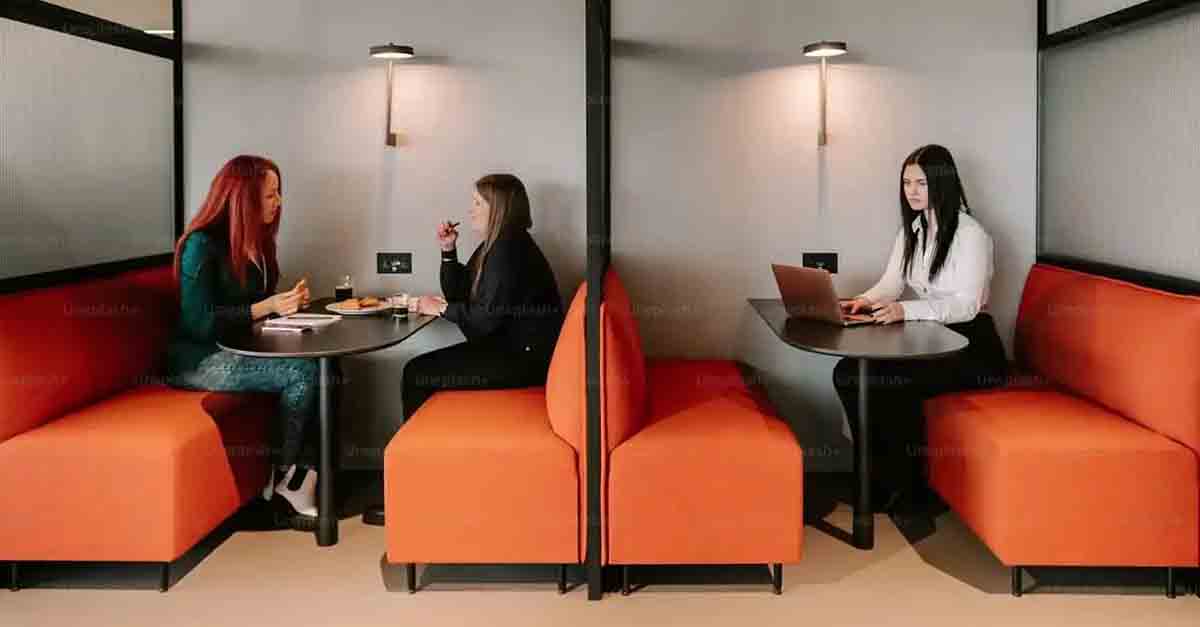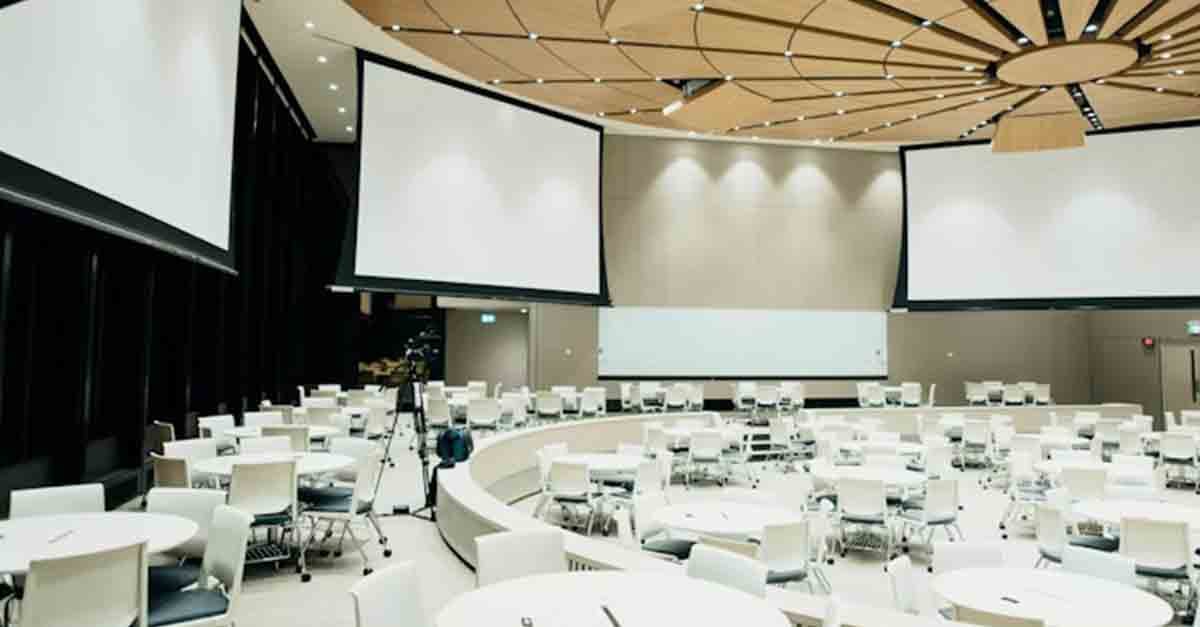
-
Home
-
Resources
-
Knowledge Hub
- Hoteling Office Space: The Benefits for Modern Workplaces
-
Home
-
Resources
-
Knowledge Hub
- Hoteling Off...

In 2024, hybrid working styles have become the norm. To respond to this trend, organizations have increasingly adopted flexible workspaces like hoteling office spaces. This method allows employees to reserve workstations as needed, rather than assigning permanent desks.
This article will delve into the concept of hoteling, examine its benefits, and explore how it can be implemented to support modern companies.
What is Hoteling Office Space?
Hoteling office space is a flexible workplace strategy where employees do not have permanent desks. Instead, they reserve workspaces as needed. This concept has gained traction in recent years with the shift towards more dynamic and agile work environments. It has been an answer to accommodating remote work and fluctuating office attendance.
Originally developed in the 1990s to optimize space utilization and reduce real estate costs, hoteling has evolved to support a mobile workforce. Adaptability and flexibility are a top priority for employees in the modern workplace. With hoteling, companies can answer that desire from workers while maximizing space.
The Evolution of Workspaces: From Fixed Desks to Hoteling
The idea of the modern office is continually shifting. Traditional office setups typically used fixed desks assigned to each employee. However, the modern business world demands greater flexibility and efficiency. This leads to the shift towards more agile environments.
Hoteling office space is a response to this trend. It offers a dynamic and cost-effective solution by allowing organizations to optimize real estate usage according to actual demand. With the right technology solution for hoteling, it is easy to book workspaces, manage resources, and facilitate communication. Through advanced software and mobile applications, hoteling helps workplaces adapt to their ever-changing needs.

5 Benefits of Hoteling Office Space
Hoteling office space is transforming how companies manage their physical work environments by blending flexibility and efficiency. Here are five key benefits of adopting hoteling in office spaces:
1. Optimize Space Utilization and Reduced Costs
Stop wasting space. Hoteling minimizes unused office space and reduces overhead expenses by adapting workspace allocation to real-time needs. This strategy means companies significantly cut costs associated with maintaining underutilized work areas. It is about allocating space and resources in the most effective manner possible.
2. Boost Employee Productivity Through Flexibility
Empower employees. The flexibility offered by hoteling directly correlates with an increase in employee productivity and job satisfaction. Think about it: By allowing employees to choose when and where they work, hoteling accommodates individual work preferences and styles. For employees and employers alike, that means improved focus, efficiency, and overall happiness.
Companies that adopt a flexible mindset and instill trust within their organizations will find success in retention rates and create a collaborative workspace that people are excited to be a part of.”— Forbes Technology Council
3. Promote Collaboration and Cross-Departmental Interaction
Build a culture of teamwork and reliability. The dynamic nature of hoteling encourages collaboration by enabling employees to easily work alongside different teams. This fluid setup fosters cross-departmental interactions and idea-sharing. That can spark innovation while strengthening team cohesion.
4. Adapt to a Mobile and Agile Workforce
Answer the needs of the modern employee. Hoteling caters to a workforce that is increasingly mobile and agile. By providing flexible work arrangements, hoteling supports employees who travel frequently, work remotely, or have irregular schedules. It is easier for them to integrate seamlessly into the office environment when needed.
5. Advance Sustainable Workplace Practices
Decrease the carbon footprint. By reducing the need for extensive physical infrastructure and cutting down on energy consumption, hoteling helps companies practice and advance sustainable workplace practices. Additionally, the approach aligns with a growing corporate responsibility towards environmental sustainability.
How to Start a Hoteling Program in an Office
Implementing a hoteling program can lead to considerable cost savings and increased employee satisfaction. But where to begin with space management? Here is a step-by-step guide on how to start a hoteling program in an office.
Step 1: Assess Workplace Needs and Feasibility
Begin by conducting a thorough analysis of current space usage and employee work patterns to understand the baseline needs. Engage with stakeholders from various departments. This provides insights into the potential impact and benefits of a hoteling system. Evaluate the cost-benefit ratio to determine the feasibility and potential savings from implementing such a program. The key here is to find out how well workspace management aligns with company goals and employee needs.
Step 2: Develop a Clear Hoteling Policy
Then, create a comprehensive set of guidelines that define who is eligible to use hoteling, when, and how the process works. Establish clear rules for booking, utilizing, and vacating the workspaces to prevent any confusion or misuse of the system. Clearly communicate the inner workings of this system to the company. There should be no questions on how the system works to prevent any misuse or misunderstandings.
Step 3: Choose the Right Hoteling Software
Next, select a hoteling software that best fits the company's specific needs and budget. The software is the foundation of the hoteling system, so it must be intuitive and reliable. Moreover, the software should integrate seamlessly with existing systems such as calendars and facility management tools. Look for software with user-friendly features that enable easy booking and management of spaces, such as EMS software.
Step 4: Set Up the Physical Space
Identify which areas within the office will be designated for hoteling and prepare these spaces accordingly. Equip them with necessary technological tools and office supplies. Consider different work styles and privacy requirements when designing the layout to ensure the spaces meet a broad range of needs. Spend considerable time on this step. Physical layouts that answer employees' needs will determine how well the system works.
Step 5: Train Employees and Managers
Do not assume people will notice it without any challenges. Organize comprehensive training sessions for both employees and managers. Make sure they are familiar with the hoteling software and policies. Focus on managers. Provide them with the skills to oversee the program and address any challenges. Offer ongoing support to facilitate a smooth transition.
Step 6: Launch the Program and Gather Feedback
Finally, push the hoteling program live. But start with a pilot phase to iron out any issues before a full rollout. Encourage employees to provide feedback on their experiences. Use that feedback to assess the program and its effectiveness. Over time, continuously refine and improve the program based on feedback and collected usage data. This is how companies can meet evolving workplace needs.

Key Features of Hoteling Office Space Software
Finding the right space management software is tricky. The platform should offer both comprehensive and intuitive features. Here are what companies should look for when selecting:
1. User-Friendly Interface
The interface of the software should be intuitive, with a booking system that simplifies the process of reserving desks and rooms. Desk booking software should also provide clear availability calendars and floor maps to facilitate quick selection of spaces. For added flexibility, mobile app compatibility is important. This allows users to make reservations and manage their bookings from anywhere.
2. Flexible Configuration Options
The software needs to have customizable settings that can be adjusted to fit different office layouts and organizational policies. It should let administrators define user roles and permissions, providing effective access control over office spaces. Moreover, the ability to integrate with existing software systems, such as calendar apps and facility management tools, is important for creating a cohesive ecosystem.
3. Resource Management Capabilities
One of the foundational benefits of hoteling is efficient resource management. Optimize space utilization with features like real-time tracking of desk and room occupancy. Then, automated check-in and check-out processes reduce annoying administrative burdens. Additionally, reporting and analytics tools help monitor usage patterns and support informed decision-making based on hard data, not instinct.
4. Communication and Collaboration Tools
The software should include built-in messaging and notification features to keep users updated on important announcements and changes. Integration with collaboration platforms helps coordination among teams — particularly for remote or hybrid work arrangements. Further, for companies embracing the modern flexibility of work, virtual meeting rooms provide the space for collaboration across different physical locations.
Accruent’s EMS Software: Best Office Space Hoteling Software
Accruent’s EMS software is an advanced tool designed to facilitate the management of office spaces — particularly for organizations using hoteling strategies. This software easily integrates with existing corporate systems, such as calendar applications. It provides a robust platform that supports both the planning and spontaneous booking of workspaces. As innovative software, it is designed to adapt to the dynamic needs of the modern workplace.

EMS Software offers a range of benefits and features that can significantly improve space management, such as the following:
- Seamless Integration: Connects smoothly with corporate infrastructure and calendar systems for coordinated scheduling.
- User-Friendly Interface: Features an intuitive interface that simplifies the process of navigating and booking spaces for all employees.
- Advanced Security Features: Protects sensitive data with robust security protocols.
- Scalable Architecture: Designed to accommodate growth and adapt to expanding workspace needs.
- Real-Time Booking: Allows employees to book desks and rooms instantly.
- Space Utilization Insights: Offers accurate analytics on how spaces are used to help optimize future layouts and resource decisions.
FAQs About Hoteling Office Space
What is the difference between hot desking and hoteling?
Hot desking is when employees choose any available desk upon arrival without prior booking. This allows for spontaneity and flexibility. Hoteling, however, requires employees to reserve a workspace in advance. It provides more structure and the ability to plan workspace usage.
What are hotel workspaces?
Hotel workspaces are flexible office areas where employees can reserve desks or rooms for a limited time based on their specific needs. This system supports a dynamic work environment by providing spaces that can be booked in advance. They are tailored to fluctuating work demands and employee schedules.
What is reverse hoteling?
Reverse hoteling is a variation of hoteling where employees have assigned desks but can be released for use by others when not needed. This is a way to maximize workspace utilization by allowing for the temporary availability of personal desks. It is about accommodating the needs of other colleagues or visitors.
You might also like
Related Reads


What is Hot Desking — and How Can You Implement It?
Gain insights into hot desking, a flexible workspace strategy that allows employees to choose their desks as needed. Understand its role in modern ...

Hot Desk Booking Software: Overview & Benefits
Explore the features and advantages of hot desk booking software, designed to optimize workspace utilization and flexibility. Learn how software can ...



